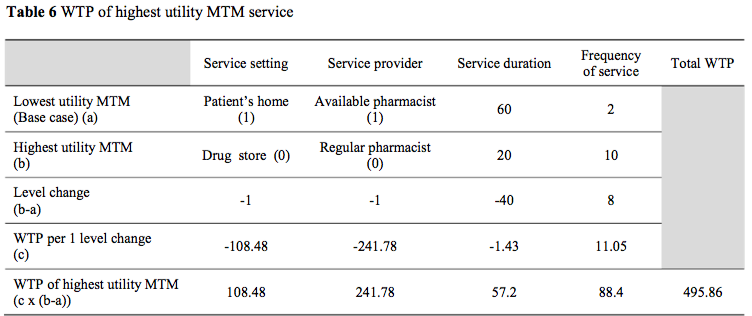
Preference on Medication Therapy Management (MTM) Service: Results from Discrete Choice Experiment
Abstract
Objectives: To assess preference and estimate willingness to pay (WTP) for medication therapy
management (MTM) service.
Method: A discrete choice experiment (DCE) was conducted in general population. The five relevant
MTM service attributes (service setting, service provider, length of service, frequency of follow up and service fee) were identified from literature reviews, face-to-face interview and survey. The DCE included 7 choice tasks composed of five attributes, two service profiles, and none option using a statistically efficient design. Six questionnaire sets were randomly assigned to 346 samples. The multinomial logistic regression was used to estimate preferences and WTP.
Results: The totals of 265 questionnaires were included in the analysis. All five attributes had statistically significant impact on respondents’ utility of MTM service (p<0.05). MTM service at drugstore was preferred to home visit and services provided by the same pharmacist was preferred to any available pharmacist. Moreover shorter length of service and follow up with less frequency were preferred. The highest utility model was MTM service provided by the same pharmacist at the drugstore with 20 minutes length of service, 10 weeks follow up, and 150 baht service fee.
Conclusions: MTM service was beneficial and valued by consumers. The WTP and attributes obtained from the study could be used to design pharmacy service benefit package to match with consumer needs and characteristics as well as the amount of reimbursement for pharmacy services.
Full Text:
119-126:PDFReferences
K. B. Blake, S. S. Madhavan, V. G. Scott, and B. L. Meredith Elswick. Medication therapy management services in West Virginia: pharmacists' perceptions of educational and training needs, Res. Social Adm. Pharm. 5(2): 182-188 (2009).
The American Pharmacists Association and the National Association of Chain Drug Stores Foundation. Medication therapy management in pharmacy practice: core elements of an MTM service model. 2008; Available from: http://www.accp.com/docs/positions/misc/ CoreElements.pdf.
J. M. Brooks, E. J. Unni, D. G. Klepser, J. M. Urmie, K. B. Farris, and W. R. Doucette. Factors affecting demand among older adults for medication therapy management services, Res. Social Adm. Pharm. 4(4): 309-319 (2008).
J. C. Lauffenburger, M. B. Vu, J. I. Burkhart, M. Weinberger, and M. T. Roth. Design of a medication therapy management program for Medicare beneficiaries: qualitative findings from patients and physicians, Am. J. Geriatr. Pharmacother. 10(2): 129-138 (2012).
B. J. Isetts, S. W. Schondelmeyer, M. B. Artz, L. A. Lenarz, A. H. Heaton, W. B. Wadd, L. M. Brown, and R. J. Cipolle. Clinical and economic outcomes of medication therapy management services: the Minnesota experience, J. Am. Pharm. Assoc. 48(2): 203-211 (2008).
A. Rosenquist, B. M. Best, T. A. Miller, T. P. Gilmer, and J. D. Hirsch. Medication therapy management services in community pharmacy: a pilot programme in HIV specialty pharmacies, J. Eva.l Clin. Pract. 16(6): 1142-1146 (2010).
L R. Moczygemba, J. C. Barner, K. A. Lawson, C. M. Brown, E. R. Gabrillo, P . Godley, and M. Johnsrud. Impact of telephone medication therapy management on medication and health-related problems, medication adherence, and Medicare Part D drug costs: a 6- month follow up, Am. J. Geriatr. Pharmacother. 9(5): 328-338 (2011). [8] P. Hilsenrath, J. Woelfel, A. Shek, and K. Ordanza. Redefining the role of the pharmacist: medication therapy management, J. Rural Health. 28(4): 425-430 (2012).
S. J. Shoemaker and A. Hassol. Understanding the landscape of MTM programs for Medicare Part D: results from a study for the Centers for Medicare & Medicaid Services, J. Am. Pharm. Assoc. 51(4): 520-526 (2011).
L. R. Moczygemba, J. C. Barner, C. M. Brown, K. A. Lawson, E. R. Gabrillo, P. Godley, and M. Johnsrud. Patient satisfaction with a pharmacist-provided telephone medication therapy management program, Res. Social Adm. Pharm. 6(2): 143-154 (2010).
B. F. Wijnen, R. J. de Kinderen, A. J. Colon, C. D. Dirksen, B. A. Essers, M. Hiligsmann, F. S. Leijten, P. P. Ossenblok, and S. M. Evers. Eliciting patients' preferences for epilepsy diagnostics: a discrete choice experiment, Epilepsy Behav. 31: 102-109 (2014).
K. Gerard, M. Tinelli, S. Latter, A. Blenkinsopp, and A. Smith. Valuing the extended role of prescribing pharmacist in general practice: results from a discrete choice experiment. Value Health. 15(5): 699-707 (2012).
K. Payne and R. Elliott. Using DCE to value preferences for pharmacy services, Int. J. Pharm. Pract. 13(1): 9-20 (2005).
S. H. Hong, J. Liu, J. Wang, and L. Brown. Conjoint analysis of patient preferences on Medicare medication therapy management, J. Am. Pharm. Assoc. 51(3): 378-387 (2011).
M. Amaya-Amaya, M. Ryan, and K. Gerard. Using discrete choice experiments to value health and health care. In I. J. Bateman (ed.), The Economics of Non-Market Goods and Resource Vol. 11, Springer: Netherland, 2008.
M. Ryan. Using conjoint analysis to take account of patient preferences and go beyond health outcomes: an application to in vitro fertilisation, Soc. Sci. Med. 48: 535-546 (1999).
A. P. Nieboer, X. Koolman, and E. A. Stolk. Preferences for long- term care services: willingness to pay estimates derived from a discrete choice experiment, Soc. Sci. Med. 70(9): 1317-1325 (2010).
P. Naik-Panvelkar, C. Armour, and B. Saini. Discrete choice experiments in pharmacy: a review of the literature, Int. J. Pharm. Pract. 21(1): 3-19 (2013).
E. W. de Bekker-Grob, M. Ryan, and K. Gerard. Discrete choice experiments in health economics: a review of the literature, Health Econ. 21(2): 145-172 (2012).
Refbacks
- There are currently no refbacks.

